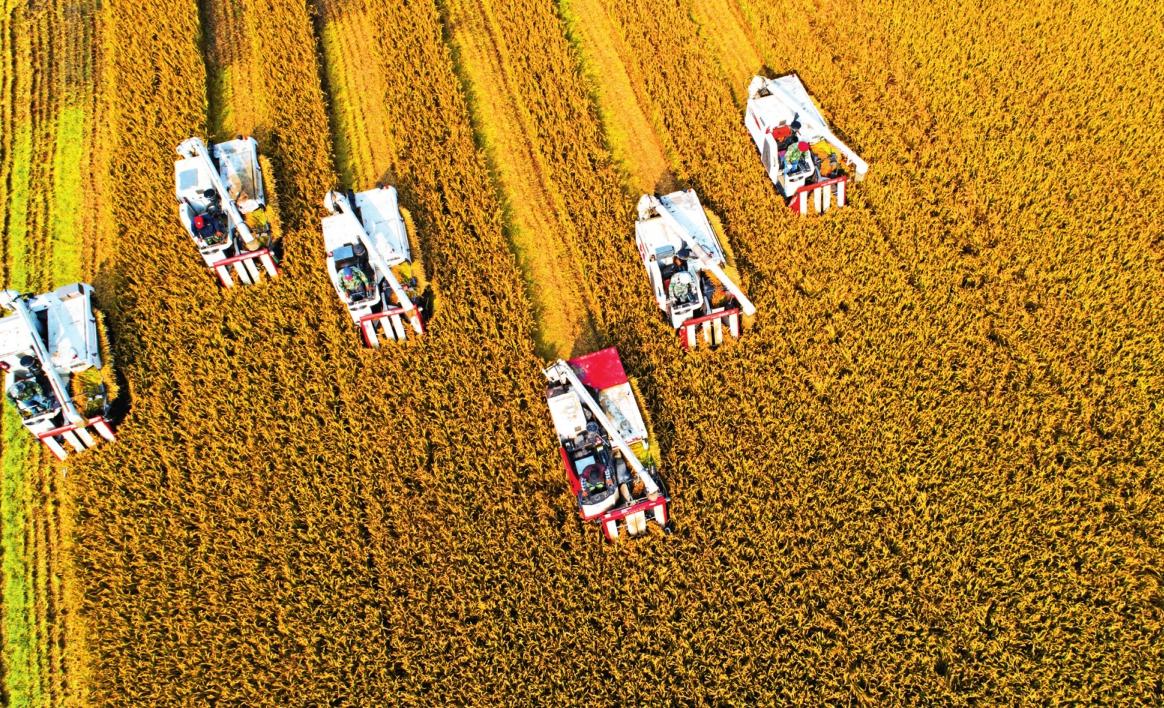Chinese Agriculture Over 70 Years:Strong Growth through Institutional Innovation
By DU ZHIXIONG & XIAO WEIDONG

THIS October marks the 70th an- niversary of the founding of the Peoples Republic of China. Like other aspects of the country, the agricultural sector has made remarkable achievements despite some twists and turns over the past years, supporting a huge population with limited resources.
Evolution of the Operational System
The land reform after the founding of the PRC established the basic operational system in rural China. The reform in the early years of the PRC gave farmers equal land rights, and created the system of private ownership and operation of farmlands. The cooperative movement between 1953 and 1956 was aimed to establish mutual-aid and cooperative production among farmers on the basis of private ownership of lands. From 1957 to 1978, China applied the peoples commune system, under which rural lands were owned and operated collectively, and farmers were remunerated according to their “work points.”
After the reform and opening-up was initiated in 1978, the rural household contract responsibility system replaced the peoples commune system, initiating a two-tier management system that in-tegrated unified alongside separate management on the basis of household contract management. The rural household contract responsibility system greatly aroused the enthusiasm of farmers, and remarkably increased the efficiency of agricultural production. Studies show that it was responsible for about 50 percent of agricultural growth and 35 percent of grain output growth in the early stage of reform and opening-up.
In the 1990s, the rural household contract responsibility system continued to be strengthened and improved, adding vigor to Chinese agriculture. In the 2010s, Chinas central authorities made clear the direction of separating the three rights – ownership right, contracting right, and management right – a reform in the countryside in response to farmers desire of retaining the contracting right but transferring the management right over their lands as more of them migrate to cities for job opportunities. This reform is a major institutional innovation in Chinese agriculture and the self-improvement of its basic operational system. It conforms to the law that the relations of production must adapt to the development of the productive forces, and attests to the vitality of the basic operational system of Chinese agriculture.
The 19th National Congress of the Communist Party of China (CPC), convened in October 2017, declared, “Rural land contracting practices will remain stable and unchanged on a long-term basis; the current round of contracts will be extended for another 30 years upon expiration.” This strategic decision will further consolidate and improve the basic operational system of Chinese agriculture, which has underpinned the strong growth of the sector since the founding of the PRC, especially since the commencement of reform and openingup. As China endeavors to rejuvenate its countryside, this system of collective ownership and contracted management of farmlands will be maintained for a long period to come.
In recent years, on the basis of the rural household contract responsibility system, rural reforms are going to greater depths in light of the circumstances of changing situations in rural areas: More farmers are working in cities and non-farming sectors; contracted lands change hands at a higher frequency; there are more intensive agricultural operations that are specialized, well organized, and commercialized; new types of entities of agricultural production and services are cropping up including large family farming businesses, family farms, farmers cooperatives, leading agricultural enterprises, and service-providing agribusinesses; and new modes of agricultural operation are maturing.
Large family farming businesses and family farms are the main force in the production of grains and other key produce. Family operation of farmlands is fundamental to Chinas agricultural production. Farmers cooperatives play the role of networking, organizing, serving, and guiding individual farmers. Leading agricultural enterprises lead the way in the production of high-end agricultural products. And service-providing agribusinesses provide assistance to all kinds of agricultural entities.
In short, agricultural entities in China have changed from predominantly famers collectives in the beginning of the PRC to individual families in the early stage of reform and opening-up, and later to greater diversities of players who coexist, divide the labor, and collaborate with each other. Consequently, a multi-dimensional, composite system of modern agricultural operations has come into being. It is based on family operation, bonded by cooperation and association, bolstered by commercial- ized services, and allows the development of all operation modes.
New Industries, New Forms of Business, and New Growth Drivers
Prior to the reform and opening-up, the government set the prices for farm products and monopolized procurement from farmers and retail. The surplus of the agricultural sector was diverted to the industrial sector to fuel the latters development. By contrast, agriculture received considerably less fiscal support from the state. From 1952 to 1978, the spending on agriculture from the state budget amounted to a total of RMB 157.7 billion, or RMB 5.4 billion on average per year. During this period, RMB 391.5 billion was funneled from the agricultural to the industrial sector at the rate of RMB 13.5 billion annually.
In addition to the rural household contract responsibility system, since the start of reform and opening-up, China has rolled out a number of policies to support agriculture and farmers, constantly optimizing and strengthening the agricultural support and protection system. They include establishing a circulation system of farm produce in line with WTO rules, setting minimum state grain purchase prices among other pricing reforms, improving the ways that subsidies are granted under the system of guaranteed base prices for agricultural products, the policy on the state purchase and storage of major agricultural produce, steadily increasing state inputs in agriculture, optimizing these inputs, and reforming the methods of agricultural investment and financing. China has also lightened the burden of farmers by rescinding the agricultural tax and reducing or exempting agriculture-related taxes, reformed the fiscal system at the county and township levels, steadily improved the public finance system and agricultural subsidy policies, developed rural financial organizations, and renovated rural credit and agricultural insurance products and services, hence intensifying the support for and protection of agriculture and farmers.

